by Selvi Viswanathan
In the Spring of 2022, I had a very rare observation of a pair of RedBreasted Robins rearing their family’s two broods right on the front porch of our home ‘Srinivas’. This location was ideal for me to watch the entire episode of this pair from beginning to end. I saw them choose a place to nest and watched the babies leaving the nest from my living room window and front door. Watching these parents raising their offspring was a pleasant experience I never expected to have the opportunity to see right in our own home! So I started taking notes like my father used to do, hoping to record them. My son, Hari, helped to take the pictures with his Canon camera without disturbing the birds because the parents might abandon the nest. Hari sat quietly and waited for the mom robin to come; that is when the hungry babies came out to be fed. Patience was necessary, but Hari got a few pictures that I will include.
I remember when we were living in New City, NY, we had half an acre of land and a lawn. When Hari was two years old, he used to play outside a lot, running to get wet when the traveling sprinklers were on! One of his favorite things was to follow the hopping Robin on the lawn. That was our first sighting of this bird. Now Hari is taking pictures of the nest with hatchlings, reminding me of the days when he was a toddler.
I began taking notes on Mother’s Day, and only today, on Christmas day, have I started to record my sightings.
May 8th, 2022 (Mother’s Day): We have had a honeysuckle vine on our front porch for many years, and I noticed a bird sitting in the nest, which was built by Canyon Towhees a few years ago. The towhees never used the nest to raise the babies. A pair of house finches used it to roost, as I noticed the bird droppings on the floor under the nest. I asked Hari and Nathan (my husband’s American name) to look, and they confirmed it was not a Towhee but bigger and that it was a ROBIN! It was a surprise indeed! The Robin seemed to have worked on the nest to make it slightly bigger. The nest was positioned a few inches below the ceiling of the porch.
May 10th, 2022: We watched the nest and were surprised when a Robin started sitting in it. We all started keeping an eye out. Sitting down, I could see the activity in the nest with a much better view. The Robins usually lay one egg each morning until its clutch is 4 eggs, and they are bluish in color. The Internal temperature of a Robin is 104 degrees F, so when it sits on the eggs, the low outside temperature does not hurt the incubation. I was curious why the male does not help to incubate, and I found males do not have a Brood Patch. A brood patch is a patch of featherless skin on the underside of birds during the nesting season. Feathers act as inherent insulators and prevent efficient incubation. Another thing that interested me is why Robin eggs are blue, so I checked the Internet. The blue color is due to biliverdin, a pigment deposited on the eggshell when the female lays the eggs. There is some evidence that higher biliverdin levels indicate a healthier female and brighter blue eggs.
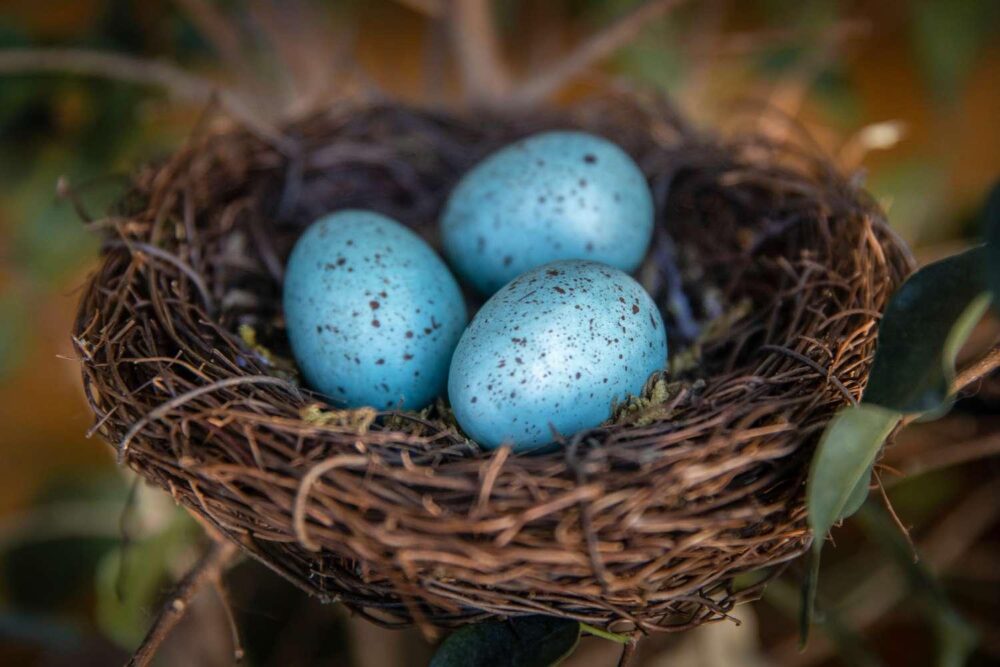
We never saw the eggs as the nest was too high, and we did not want to disturb them. The Robin can abandon the nest if it sees it has been discovered. Because the nest is near the entrance to our home, whoever comes must pass near the nest, so I warned them and was a little nervous about it. The Robin did not seem to mind, and it was patiently sitting on the nest, sometimes moving within the nest to different positions.
May 23rd, 2022: Around 1 pm, I heard the chirping of babies! I learned that incubation is a 13-day period. From the 10th to the 23rd, I only saw the mom stay in the nest. She left the nest to eat for a few minutes and came back every few hours. I did not see the mate and was disappointed. I felt that maybe taking a picture would be nice, but I hesitated. Hari carefully took a picture with his zoom lens and saw three babies, and we later found that there were four. The picture below shows mom feeding the babies.
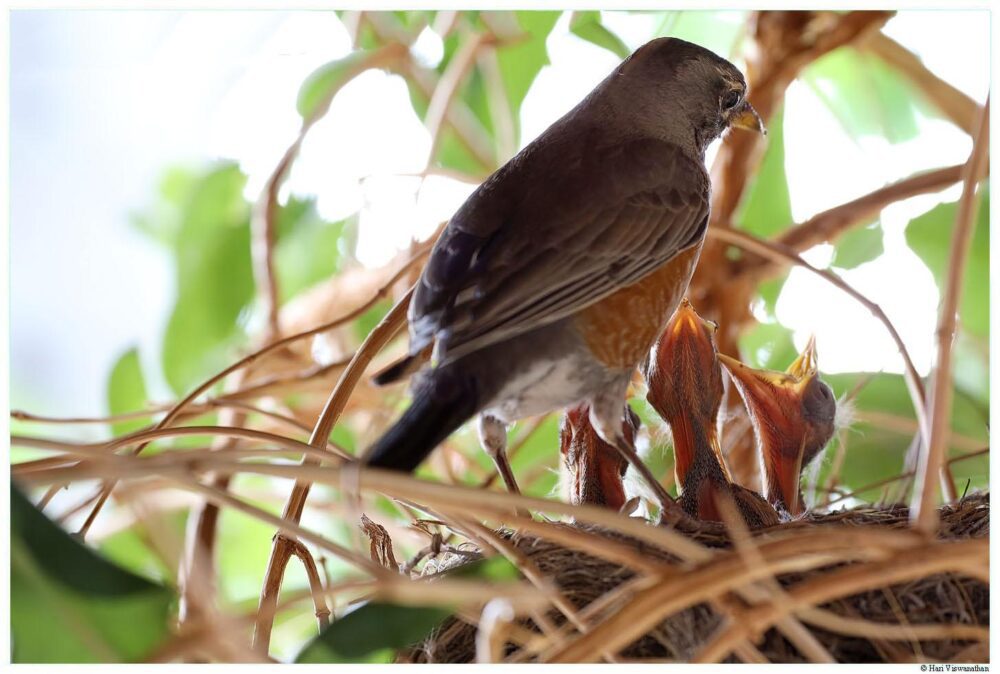
Robin hatchlings are born mostly bald. While they have a few small patches of downy feathers they are almost unrecognizable from their adult parents. This is unlike ducklings who look like their parents as soon as they are hatched and start swimming right away. A beautiful sight to see indeed.
May 26, 2022: I was delighted to see the dad helping to feed occasionally. I learned that the dad is always watching nearby and helps when needed. From inside our home, I could not see the outside trees to see whether dad was guarding or not!
June 1,2022: I was upstairs till 9 am saying prayers and taking care of e-mails, so I came down late. I heard a bird hitting the glass window frantically from our dining room area. The shades were down, so it was not because of seeing a reflection. I was concerned the bird might get hurt and even die. I came down and saw it was Robin doing it. I looked, and it was doing the same thing even when the shades were up. When it noticed me, it flew to the nearby cherry tree which was abundant with ripe cherries. It was the male, I could see the bright red breast. It looked like it was warning the other birds not to feed on cherries. Feeding babies was a priority. The dad was making sure no other birds came to this tree! The male was protecting his territory! What an exciting sight.
June 5, 2022: We noticed that the mom was the main provider. The male just landed on the rim of the nest and tried to feed, but the mom left to get food and returned fast. We saw both parents coming with the worms in their beaks often. We also saw some interesting teamwork between the SQUIRREL and the ROBIN. The cherries on the tree outside my window were ripe, and the whole tree was loaded with cherries. Suddenly a squirrel came to feed on the seeds of the cherries. It is only interested in the seed. I noticed in the past the Robins removed the seed to feed the flesh to their babies. The smart Robin noticed the squirrel dropping the fruit and took it to feed the babies. I saw this several times. I showed my husband, and he also saw the squirrel from the tree plucking the cherry, eating the seed, and throwing down the fruit while the mother robin watched from the nest. It was fun for us to see this. Below is another picture of mom feeding cherries to the babies.
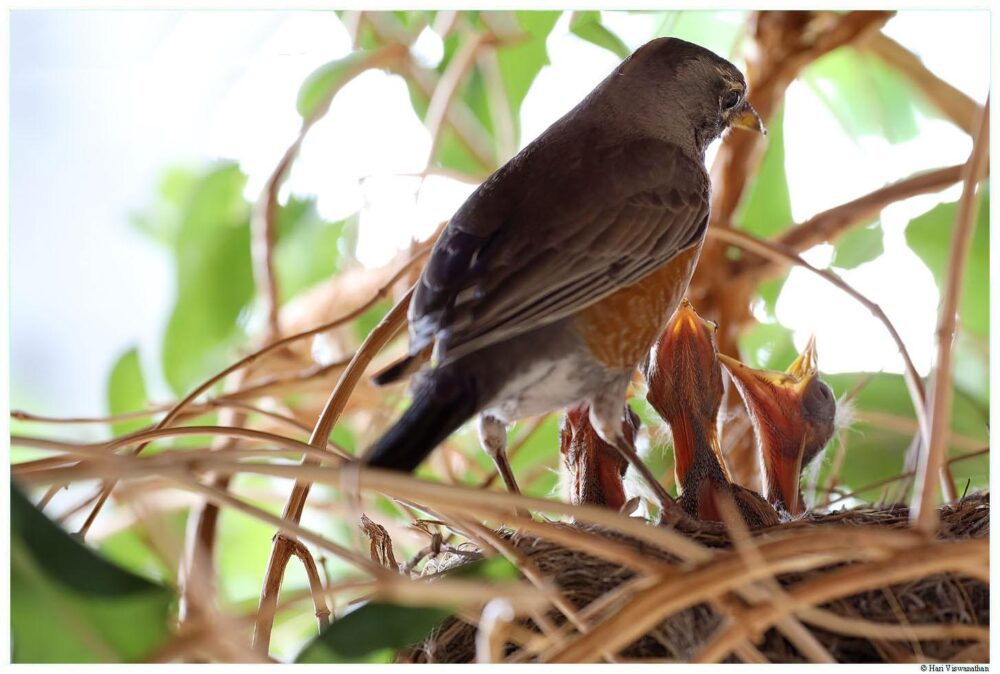
June 8th, 2022: We had a new refrigerator delivered, and there was lots of movement only a few inches from the nest. I warned the crew, and they were careful. It could have been a disaster. By Goddess consort of Lord Srinivas, the house we named Padmavati worked out fine.
June 10th, 2022: When Hari came to check the wildlife camera he set up in our yard for wildlife, he said the babies were gone! Hari saw one bird still in the nest when he left. So, I watched, and it was still in the nest until 2:20 pm. Then suddenly, it took off to the platform feeder on the tree stump nearby and waited. I took a picture with my iPhone. It stayed for a few more minutes and flew towards the next-door yard, near their garage wall. So I saw at least one leaving the nest and was happy. We did not watch how the other babies flew out from the nest. It would have been an interesting sight, but thankfully we did have some new experiences to watch. It was disappointing, but I’m glad the Robin family is out, and hopefully safe. Because the babies depend upon the parents to get fed for another couple of weeks before they become independent.
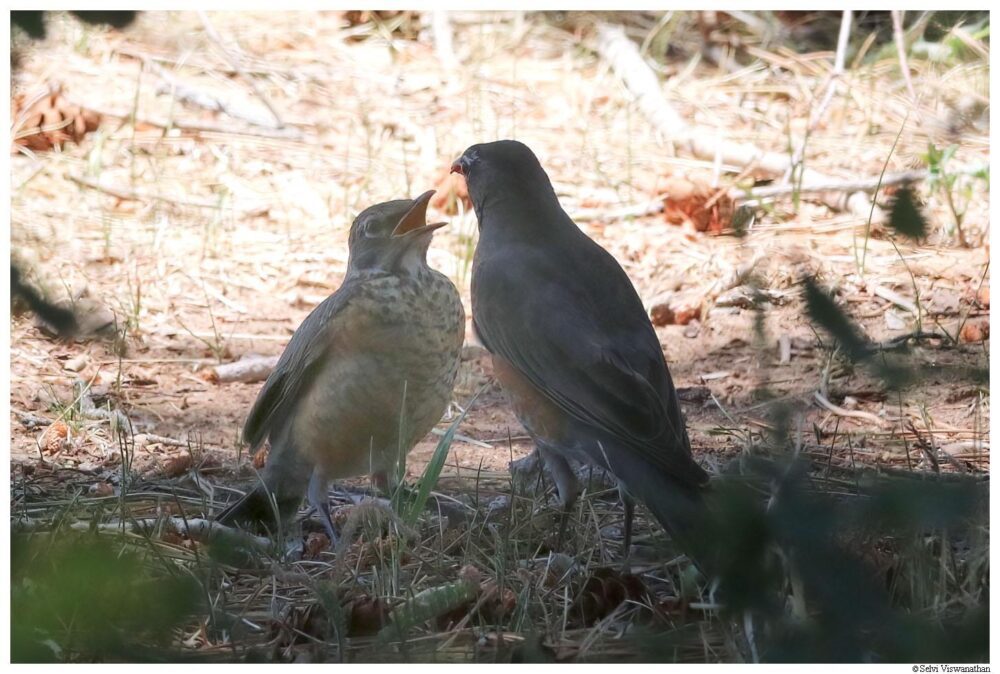
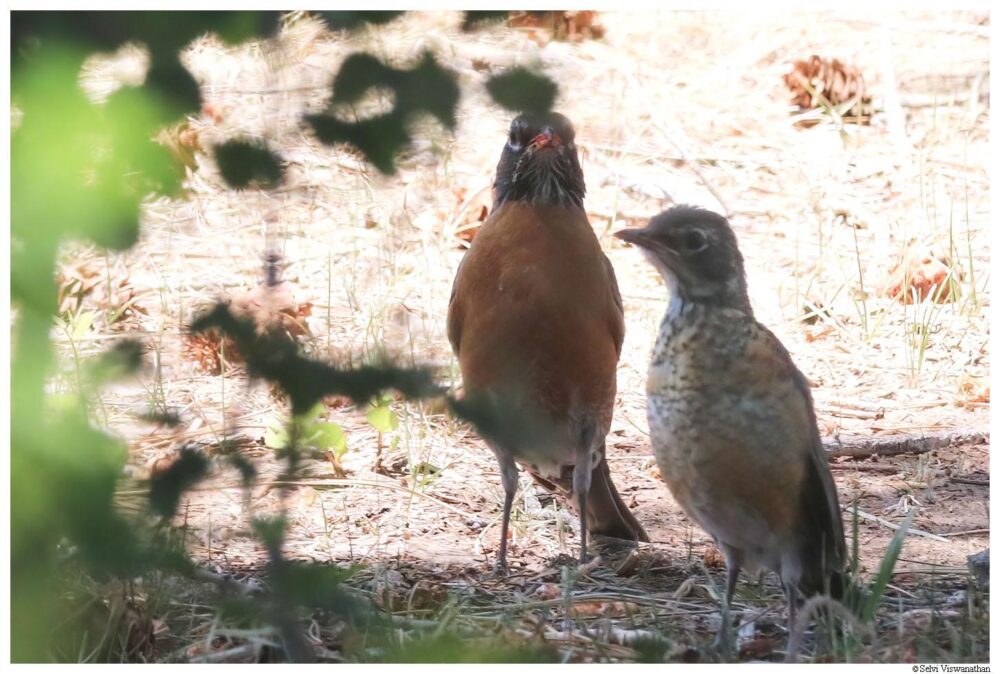
June 15th 2022: It was a lucky day, I saw an adult robin feeding a baby in the yard, and I took pictures. So the First Brood was successful, and I was thankful. Below are two pictures of dad feeding the babies.
Robin’s Second Brood
A pleasant surprise and a rare occurrence happened; the Robin mom is back in the same nest! I watched and have notes from Independence Day; the American Robin is back for the next brood.
I do not have notes between June 10th and July 4th. So, this is just my guess from what I read about the second brood. While the male has started feeding, the mom prepares for the next brood and looks for a new nesting place. Normally another site, but I saw this mom decided to use the same one in spite of the traffic and disturbances it had. I told Nathan that this mom was too lazy to build a new nest and he said she was smart because she had found a perfect place: near the pond for water, earthworms, and a cherry tree, which is also hidden from the wind. I looked in the yard for other trees and places to see any nests built. I found one on the east side of a Ponderosa tree. Looks like the mom did try and opted for the best place.
July 4th, 2022: Cloudy with a little rain. I see the babies might have hatched and this time I wanted to try watching the nest by sitting on the porch chair, which is only a few feet from the nest. The mom did not mind so I continued to do so and it worked out so much better. I could see the babies coming out when the parents came to feed them. Looks like they had four hatchlings. Another fun and exciting thing is that I could hear dad Robin singing a familiar song from the tree nearby while the mom was in the nest.
Around 7 pm there was still light outside so I came out to see the nest. I was shocked to see a garter snake near the pond very close under the nest area. It scared me! It might climb the vine and get the chicks. The mom does not stay in the nest after dusk; she just sleeps next to the nest to give the growing babies room. So I squirted water with the hose and tried to move the snake away from the area.
July 5th, 2022: It is Partly sunny. I looked to see if the snake was back and did not see it. Both parents are feeding the babies. I can sit on the porch chair and watch their feeding pattern. It seemed mom fed the smallest one more than the other babies. The dad seems to only come for a short time and feeds the babies, who come out first, popping out of the nest.
July 6th, 2022: Sitting outside rewarded me as I listened to dad singing his Cheerily song, which came from the roof above the nest. What a treat to my ears and the spot he chose was where the babies can hear and learn. I can identify the male much better now as he has a bright red breast with a black head.
July 7th, 2022: I watched from 1 pm to 2 pm. I was surprised to see the dad come and feed for a very short time, and the mom took time to return. The mom came back with a bright red cherry, and the hungry babies came to eat right away. The dad flew away maybe to find food. In the following days, both parents took turns feeding. I noticed dad waiting on the ponderosa tree nearby and going to the next-door yard to get worms.
10th July, 2022: Hari saw four babies; it is such a big task for the parents to keep bringing food.
11th July, 2022: I sat on my porch chair and could see the nest clearly from that angle; two of the babies looked larger and were growing feathers. Around 1 pm, I noticed Mr. Robin chasing the Abert squirrel, who usually comes to the ponderosa trees.
July 12th, 2022: Two babies are larger and come to the top of the nest often. They seem to be ready to take off!
July 13th, 2022: The parents are really trying hard, and sometimes both of them are in the nest simultaneously, staying for a couple of minutes.
July 14th, 2022: I watched from noon to 2 pm to make sure I did not miss the babies taking off.
July 15th, 2022: Around this time, Hari and Aditya went to Borneo for a Birdwatching trip. I had to now take care of watering the deck plants by carrying water from the front faucet. I carried the watering can five times, but it did not disturb the birds. I rested by sitting in the chair between watering and observing the nest. I found out that when the mom came she took time to decide which babies to feed, and she avoided the larger babies and fed the two smaller ones.
The Garter snake showed up in the pond, so I tried to chase it away. While I filled the back pond, I asked Nathan to sit on the porch and watch the nest. He saw both parents nearby, but they avoided coming to the nest. It seems since he is new, they are careful. They trusted me, and I am glad I could watch and hear singing by sitting outside, something I missed during the first brood.
July 16th, 2022: Two babies started preening their feathers and coming to the top of the nest. The daddy feeds these babies. I also hear singing often from the nearby tree. Sometimes when the mom is away, he tries to call, and the female does not come. But the babies are taken care of as they grow and may leave the nest soon.
July 17th, 2022: When I came down around 9.30 am and looked at the nest as always, I only saw two babies. So I went outside and noticed two of them in the next-door yard near the bushes growing along their garage wall. That made me want to watch to see the other two leave. Around 10.30 am, I saw one of them trying to sit on the rim and flapping its wings. The parents, both nearby, were watching from the tree. Suddenly the baby decided to take off and landed in our driveway.
The dad came right away to the driveway and guided the baby to a safer place because the baby was going towards the busy road. Again, I was concerned. The dad guided it to the sidewalk and then towards the yard, where we have a path made with concrete blocks. I have a rock garden along this pathway with plants and shrubs, and the baby was safely led to a place under the bush. Next, the fourth baby flew towards the pond area and yard where the other baby was. Both parents were there. This was really a rare sighting for me.
I started looking towards the next-door yard as it is where the parents are feeding the babies. It is not far from our home, only about 30ft, and I could watch and be happy that the babies are taken care of. They need another two weeks to be independent. I saw them only a couple of days, and they were gone to some other safe place.
To conclude, the third baby leaving the nest caused me to worry, but how the dad cared for and guided the baby to a safe area is commendable. So there was a happy ending! Watching the two broods was so different, as the first one I watched from inside my home and the second one I ventured out to sit on the porch in a chair, which gave me much more insight, especially watching the dad singing. I had to thank Almighty for giving me this rare experience and for the days I was confined at home because of Covid restrictions. It turned out to be a blessing in disguise. Normally the Robin is a very common bird, but to me, the way the pair handled the disturbances and the way it chose this vine was something rare that I could watch!
In the fall, we saw a huge flock of Robins coming to the back pond for bathing and drinking, so I started to wonder, “are these the robins that grew up here?” I want to think ‘yes’ they are back.
Today, on the 28th of December, it’s snowing a little, and around 1 pm, I looked at the front pond where I have slow-running water, and I was surprised to see a Robin sipping water! Now Spring is not far; only four more months until this pair will come back is the thought that came to my mind!

Dear Selvi,
Thank you for your wonderful story of the two robins raising two broods and increasing our robin population with eight chicks.
What fun to hear the father boasting about his brood and to imagine the squirrel sharing the cherry fruits and eating the nuts I was pleased and surprised that the robin parents fed their little hatchlings first. Man birds neglect the small ones, don’t they? Thank you for this wonderful story. Are you thinking of collecting them in a book illustrated by Hari? I would love to see it.
Thanks fir thinking of me and sharing your insights.
My daughter and I loved reading about how both the squirrels and robins were able to enjoy the same cherries. It was such a surprise! We also enjoyed the photos, especially the one of the newborn birds eagerly waiting for their meal. Beautifully documented!
Selvi, what a gift your patience and observations have given us! Those observations (and the research you did to answer your questions) provided such insight into the lives of those birds…the sharing twixt the robins and squirrels, the female feeding the smaller ones while the dad went for the easy open mouths, the way the male serenaded the family from the tree. The observation that touched me the most was the males care of the third baby in guiding him to a safe place. It was so good to be caught up in the drama of the two broods and, of course, the photos were stellar as well. Thanks for sharing the results of your dedication and experience with us so lyrically. It was lovely.
Dear Selvi,
Your real life experience was a delight to read. I loved it, and waiting for your next one. I am sure the Robins are grateful for your hospitality and will remember you, Hari, and Nathan forever.
Regards,
Lakshmi Sundararaman
Yesterday I was gifted with a plump robin on my back fence. It seemed early to see one, but a pleasant reminder of better weather and Spring to come.
Dear Selvi ,
Thank you for sharing your wonderful observations, research, and pictures with us!!
It brought back fond memories of many years ago. I was teaching 4 th grade in Underhill, VT when a robin built her nest outside our 2nd story window during our Spring vacation. Returning to school, I pulled the window shade so we would not disturb her and proceeded to be very quiet ! The children and I peeked around the shade and observed the feeding and growing of the robin family. As you told so well, it was a rewarding , wonderful experience!
You are a great story teller!
Selvi, you remind us all to take the time to really see what nature holds. Then we will see the extraordinary.
Selvie. Thank you for your wonderful story about the robin family! I also enjoyed the “side stories” like the one about Hari playing in the sprinklers!
It is an interesting adventure from Mother’s Day when you noticed a robin sitting in a nest built by Canyon Towhees until the 2nd brood was raised and gone.
I look forward to another chapter this spring!
Dear Selvi, It was beautiful to read your journal. I could see you sitting in the porch watching the nest,see the squirrels giving cherries without seeds . I would love to hear the robin sing. Happy V.K.V. could help you. Thanks for the beautiful journal. Ganga
Dear Mrs. Selvi,
Your vivid description of the growth cycle of Robin over a 70 day period is indeed an eye opener for people like me ! Staying in a ” concrete jungle”, I, unfortunately, have restricted ” communion with Nature”.
Your cosy home is indeed blessed by nature. In addition you too have taken many painstaking efforts to enhance its accessibility to birds and wildlife. They speak highly of your patience and hard work
I followed the “progress report “of each day with deep interest.Your detailed accounts are a reflection of your keen observation coupled with deep knowledge of the bird behaviour in your area.
They also speak of your tender & caring qualities in ensuring that the disturbance to the fledgling birds is minimised. Hari and you have taken extra care to take excellent & rare photos without scaring the birds.!
You already seem to have established an “image of a protector” among the birds. Therefore, it is no wonder that this reputation of the Viswanathans has spread informally among the birds family. They keep revisiting this safe haven that you have established solely for them at your home!!
I sincerely wish that many more bird sightings & breeding occur at your home in future too. These episodes should triggering off many more such highly readable and enlightening blogs from you ! It would be your everlasting gift to nature lovers
I sign off by wishing you , Mrs. Selvi, all round success & happiness in your multi dimensional ecological mission.
Warmest regards
Himakar Tata